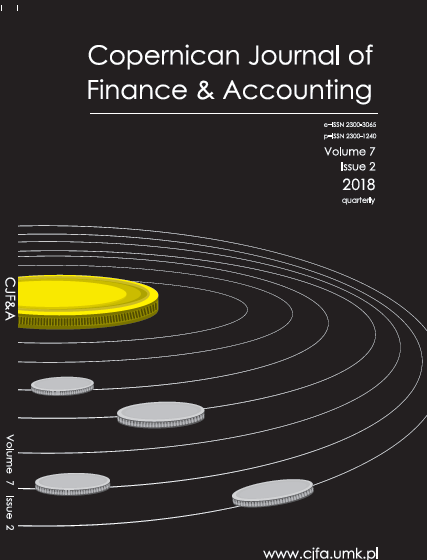THE MACROECONOMIC DRIVERS OF HOUSEHOLD DEBT-TO-INCOME RATIO: AN EVIDENCE FROME THE OECD COUNTRIES
DOI:
https://doi.org/10.12775/CJFA.2018.007Słowa kluczowe
household indebtedness, determinants of indebtedness, debt-to-income ratio, OECD countriesAbstrakt
The paper aims at empirical investigation of the key macroeconomic drivers of household debt-to-income ratio in the OECD countries using a panel data regression analysis to control for the time-invariant country-specific effects. The examined sample covers 31 countries over the period 1996–2015, yielding an unbalanced panel of 439 country-year observations. The results of the fixed-effect panel regression analysis indicate that the household debt-to-income ratio is positively related to the average annual wages, the share of population aged 25–39, the share of population with tertiary education attainment, and the magnitude of the wage-productivity gap. The interest rate and the unemployment rate seem to affect the ratio negatively, although the latter relationship turns out to be statistically insignificant. Contrary to the evidence in the relevant literature, however, after controlling for the country-specific effects, the rate of economic growth and income inequality have been found to affect the debt-to-income ratio negatively. These unexpected results might reflect the likely distortions caused by the recent global financial crisis that has significantly hampered the economic growth and increased the unemployment rate in many developed countries, while the overall household indebtedness has remained elevated. It is also plausible that a positive impact of income inequality on household indebtedness might be largely limited geographically as it reverses when a larger set of countries is examined.Bibliografia
Anundsen, A.K., & Jansen, E.S. (2013). Self-reinforcing effects between housing prices and credit. Journal of Housing Economics, 22(3), 192–212. http://dx.doi.org/10.1016/j.jhe.2013.07.001.
Barba, A., & Pivetti, M. (2009). Rising household debt: Its causes and macroeconomic implications – a long-period analysis. Cambridge Journal of Economics, 33, 113–137.
Bloxham, P., & Kent, C. (2009). Household indebtedness. The Australian Economic Review, 42(3), 327–339.
Bolibok, P. (2015). An empirical evaluation of the demand-side drivers of household residential debt: The case of Poland. Finanse, Rynki Finansowe, Ubezpieczenia, (Finance, Financial Markets, Insurance.) 74(2), 597–608.
Brown, S., & Taylor, K. (2008). Household debt and financial assets: Evidence from Germany, Great Britain and the US. Journal of the Royal Statistical Society: Series A (Statistics in Society), 171(3), 615–643. http://dx.doi.org/10.1111/j.1467-985X.2007.00531.x.
Finocchiaro, D., Nilsson, C., Nyberg, D., & Soultaneva, A. (2011). Household indebtedness, house prices and the macroeconomy: a review of the literature. Sverige Riksbank Economic Review, 1, 6–28.
Frank, R.H., Levine, A.S., & Dijk, O. (2014). Expenditure Cascades. Review of Behavioral Economics, 1(1–2), 55–73. http://dx.doi.org/10.1561/105.00000003.
Gimeno, R., & Martinez-Carrascal, C. (2010). The relationship between house prices and house purchase loans: The Spanish case. Journal of Banking and Finance, 34(8), 1849–1855. http://dx.doi.org/10.1016/j.jbankfin.2009.12.011.
Godley, W., & Lavoie, M. (2007). Monetary Economics. New York: Palgrave Macmillan.
Jacobsen, D.H. (2004). What influences the growth of household debt? Norges Bank Economic Bulletin, Q3, 103–111.
Justiniano, A., Primiceri, G.E., & Tambalotti, A. (2015). Credit supply and the housing boom. NBER Working Paper, 20874. http://dx.doi.org/10.3386/w20874.
Klein, M. (2015). Inequality and household debt: a panel cointegration analysis. Empirica, 42, 391–412. http://dx.doi.org/10.1007/s10663-015-9281-7.
Leicht, K.T. (2012). Borrowing to the brink. Consumer debt in America. In K. Porter, E. Warren (Eds.). Broke. How debt bankrupts the middle class. Stanford: Stanford University Press.
Magri, S. (2007). Italian households’ debt: The participation to the debt market and the size of the loan. Empirical Economics, 33, 401–426.
Malinen, T. (2016). Does income inequality contribute to credit cycles? Journal of Economic Inequality, 14(3), 309–325. http://dx.doi.og/10.1007/s10888-016-9334-6.
Meng, S., Hoang, N.T., & Siriwardana, M. (2011). The determinants of Australian household debt: A macro-level study. Working Papers Business, Economics and Public Policy, 2011-4.
Modigliani, F., & Brumberg, R. (1954). Utility Analysis and the Consumption Function: An Interpretation of Cross-section Data. In K. Kurihara (Ed.). Post Keynesian Economics. New Brunswick: Rutgers University Press.
Moore, G.L., & Stockhammer, E. (2018). The drivers of household indebtedness re-considered: an empirical evaluation of competing arguments on the macroeconomic determinants of household indebtedness in OECD countries. Working Papers from Post Keynesian Economics Society, 1803.
OECD (2018). OECD.Stat, http://stats.oecd.org (accessed: 20.04.2018).
Oikarinen, E. (2009). Interaction between housing prices and household borrowing: The Finnish case. Journal of Banking and Finance, 33(4), 747–756. http://dx.doi.org/10.1016/j.jbankfin.2008.11.004.
Rubaszek, M., & Serwa, D. (2014). Determinants of credit to households: An approach using the life-cycle model. Economic Systems, 38(4), 572–587. http://dx.doi.org/10.1016/j.ecosys.2014.05.004.
Stockhammer, E. (2015). Rising inequality as a cause of the present crisis. Cambridge Journal of Economics, 39(3), 935–958. http://dx.doi.org/10.1093/cje/bet052.
Taylor, J.B. (2009). The Financial Crisis and the Policy Responses: An Empirical Analysis of What Went Wrong. NBER Working Paper, 14631. http://dx.doi.org/10.3386/w14631.
Thaicharoen, V., Ariyapruchya, K., & Chuched, T. (2004). Rising Thai household debt: Assessing the risks and policy implications. Working Papers from Monetary Policy Group, 2004-01.
Turinetti, E., & Zhuang, H. (2011). Exploring Determinants of U.S. Household Debt. Journal of Applied Business Research, 27(6), 85–91. http://dx.doi.org/10.19030/jabr.v27i6.6468.
Turk, R. A. (2015). Housing Price and Household Debt Interactions in Sweden. IMF Working Paper, 15/276. http://dx.doi.org/10.5089/9781513586205.001.
United Nations (2017). World Population Prospects, http://esa.un.org/unpd/wpp (accessed: 20.04.2018).
Zinman, J. (2014). Household debt: Facts, puzzles, theories, and policies. NBER Working Paper, 20496. http://dx.doi.org/10.3386/w20496.
Pobrania
Opublikowane
Jak cytować
Numer
Dział
Statystyki
Liczba wyświetleń i pobrań: 2098
Liczba cytowań: 0



